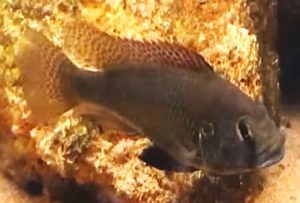Astatotilapia Desfontainii is an extremely rare, gravely threatened, and possibly extinct cichlid species that is native to Algeria and Tunisia, in Northern Africa, where it is found in freshwater springs, oasis, and in the canals and ditches of irrigated lands
Because of habitat loss partially caused by the irrigation of date palms, Astatotilapia desfontainii had been observed in the wild in only 5 locations.
Tozeur, Gafsa, an oasis in Nehmlet near Tozeur, another oasis near Nefta, and in an unspecified Algerian site reported to be possibly Biskra.
In 2006, a study made by E. Schrami found that the “extinct” species of Tozeur and Gafsa virtually disappeared from the single water channel that it was found in. Since Astatotilapia Desfontainii was found in Tunisia, many now believe it to be extinct in the wild.
As of a few years ago, there were only four adult fish in captivity in all of North America, but tropical fish keeping breeders interested in preserving the survival of the species have successfully distributed their offspring from coast to coast in the United States, as well as throughout Europe.
Astatotilapia Desfontainii possess the typical cichlid shape and laterally, is somewhat flattened. They have a large, bullish head, 3 to 9 egg spots on the anal fin, and a rounded caudal fin.
Except for the external rows of teeth, which in the case of astatotilapia are one-pointed or two-pointed, and not laterally compressed or obliquely truncated, Astatotilapia is closely related to the genus Haplochromis. The teeth of the inner rows are small and three-pointed, and on the pharyngealia, the middle rows of teeth are enlarged and sometimes “tooth-like”.
Mature male Astatotilapia Desfontainii are olive green in color, but each of the scales along the flank has a small, bright, blue green reflective dot which gives the fish a different color appearance relative to the angle and direction of the light source it is viewed from. Males are larger and more strikingly colored than females.
Astatotilapia Desfontainii can be kept in a medium sized aquarium with a sandy gravel substrate and some rocks as decoration. They prefer and tolerate higher water temperatures and in the wild have been found in larger numbers in areas fed by irrigation water up to 130° F. Their tank should be provided with regular water changes and moderate filtration.
Breeding Astatotilapia Desfontainii is similar to Astatotilapia flaviijosephi and like the Jordan Mouthbrooder, they are both maternal mouthbrooders.
When ready to spawn, the male will fan out a pit in the gravel at the base of a rock where spawning eventually occurs. The male will entices a gravid female into the pit with a series of shimming gyrations and circling activity. As the eggs are dropped by the female, she will continuously circle the male and scoop an egg or two into her buccal cavity until the spawning is completed. The
male will then expose his anal fin to the female who will nip at it, stimulating the release of milt to fertilize the eggs.
The eggs are relatively small and a single brood can produce over 50 fry per spawning. The eggs are incubated in the mouth of the female for a period of about 18 days, and the fry are protected by the female for up to two weeks after hatching. After the spawning takes place, the male will leave the female to fend for herself.
In their natural habitat, Astatotilapia Desfontainii are omnivores that feed on insects, small organisms, algae, and probably smaller fish.
In an aquarium environment they can be fed a quality omnivore cichlid pellet as a staple, augmented with regular offerings of snails, earthworms, mysis shrimp, etc.
Astatotilapia Desfontainii are very rare and obviously not available to tropical fish keeping enthusiasts from local fish shops or even online. They may be periodically offered for sale from breeders on a limited basis through Cichlid Forums, Cichlid societies, or other online sites.
Minimum Tank Size: 30 gallons
Care Level: Easy
Temperament: Semi Aggressive
Aquarium Hardiness: Very Hardy
Water Conditions: 71-83° F, dH 18-30, pH 7.0-9.0
Max. Size: Males 5.9″, Females 5″
Color Form: Olive Green
Diet: Omnivore
Compatibility: Single species tank or w/other African cichlids
Origin: Algeria, Tunisia
Family: Cichlidae
Lifespan: 5 years ?
Aquarist Experience Level: Intermediate




